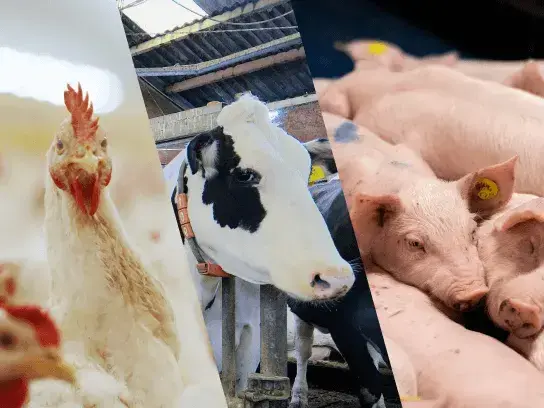- Poultry
- Laying Hens
- 2 minutes read
The light climate is an essential part of the overall climate in layer houses. Laying hens see differently than human beings. This means the light climate should be adjusted accordingly. An optimal light climate increases layer vision and improves their behaviour, welfare and performances. Now, how does this look in practice?
Let’s dive into the 4 key benefits of optimal layer lighting.
1. Improved egg production & shell strength
The higher the quantity and quality of the eggs, the better the company results.
Optimal lighting makes sure the birds mature properly and it stimulates them to start laying eggs. By providing the correct light spectrum, shell strength can be optimised as well. Lighting is also able to stimulate feed- and water intake on one side and reduce stress & energy usage on the other. This together will decrease and thus improve the feed conversion rate.
As you can imagine, this all contributes to a higher amount of stronger eggs.
2. Less stress
As with humans, stress is not good for a laying hen’s well-being, health and performances. The lower the amount of stress, the better the performances.
The main role of an optimal light climate is to improve a laying hen’s vision. When they see better, they will feel more at ease. This automatically results in a lower amount of stress. Besides optimising their vision, it’s important to provide flicker-free lighting. When the hens observe flicker (rapid fluctuation of the light intensity of the lamp), they may perceive this as a threat. Stress is a logical result of this.
Just some of the benefits of a lower amount of stress are an improved Feed Conversion Rate, improved egg production and less unwanted behaviour.
3. Aviary houses: Less floor eggs
Floor eggs are a well-known problem in aviary houses. The lower the amount of floor eggs, the higher the amount of usable eggs and the lower the amount of time needed to collect eggs by hand. This surely makes life easier.

The most influential way in which lighting can reduce floor eggs is by realising an optimal light distribution. This means that the right amount of light is provided at the right place in the house. The best way to realise this is to set up a custom-made light plan to create a light climate that is adjusted to the needs of the house and the animals in it.
In this way, desired behaviour can be stimulated, which reduces the amount of floor eggs.
4. Cage systems: Uniform sexual maturity & egg laying performances
Especially in cage systems, realising uniform performances throughout the house is a major challenge. Reaching a high level of uniformity can significantly improve results.

An optimal light distribution is key here, since it is the best way to foresee an equal living environment on all tiers and in all cages. By providing an equal and optimal environment for all hens, body weight differences can be reduced. This enables them to mature uniformly and prevents lower performances in parts of the house.
In this way, a uniform sexual maturity and uniform, better egg laying performances can be realised.
Improving life through brightness
As you can see, optimising the light climate can significantly improve laying hen welfare and performances in several ways. Improved company results in a responsible way are a logical result of this. Are you aiming for more & stronger eggs, less bird stress and more?
Stay informed
Lighting matters. That's why we share our knowledge with the world through HATO Insights.
Poultry
Beak Trimming Bans: Lighting the Way Forward for Poultry Welfare
The practice of beak trimming in laying hens has long been a controversial topic within the poultry industry. With increasing concerns for animal welfare,...
Pigs
7 Key Ways Light Cycles Enhance Animal Health and Boost Productivity
Light is a fundamental aspect of life, influencing the daily routines and overall well-being of animals. In this comprehensive guide, we explore seven key ways...
Since 1974, we've been working on the best lighting solutions for the agricultural sector.
Improving life through brightness
HATO Insights
Find out how switching to good LED lighting improves performance and reduces costs.
Learn how color lighting affects different poultry species and improves their performance

.webp)
.webp)


